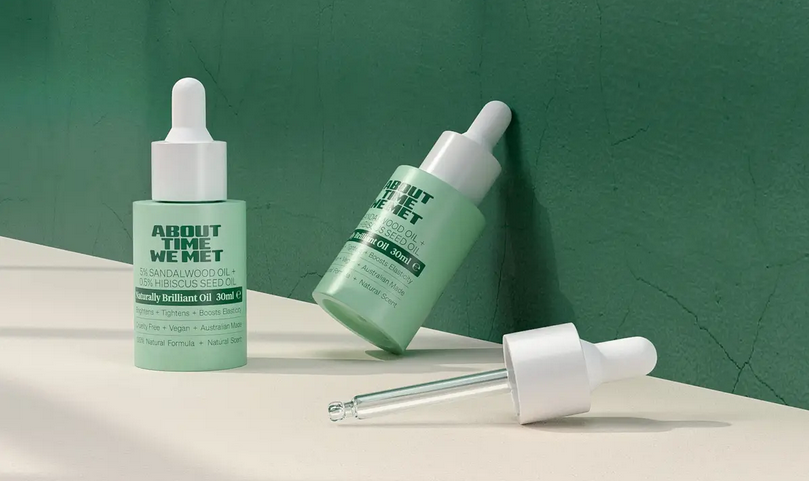New high-end product line shows the potential of sandalwood as active ingredient
Skin care that prevents skin ageing, conceals fine lines and is good for the complexion altogether – sounds like an advertising promise you’ve heard many times before. The experts at Quintis, our Australian partner in sandalwood cultivation and refinement, have made this promise their mission. The core idea of the new product line is to give the active ingredient sandalwood a stage and let the results speak for themselves.
A blueprint for the international skin care industry
About Time We Met is a concrete use case for cosmetic companies around the world, encouraging them to use sandalwood oil and powder as an ingredient in (new) high-end skin care products. The product line offers the ingredient sandalwood unprecedented relevance as an active ingredient in the skin health industry. Thus, the spectrum and potential of sales opportunities for sandalwood is expanding.
In addition, About Time We Met illustrates the medicinal potential of Santalum album and combines it with already established ingredients. With retail prices reaching up to USD 30,000 per kilogram of sandalwood oil, the product line’s retail prices are also in the significantly higher price range. Thus, 30ml of Naturally Brilliant Oil with 5% sandalwood oil, for example, can be purchased for around 80 USD (115 AUSD).
Powerhouse sandalwood outshines Vitamin E
Santalum album has been proven to be a stronger antioxidant than vitamin E. This means that it can provide significantly better protection against blue light and free radicals. In addition, it has been scientifically proven that sandalwood oil prevents collagen damage in the skin caused by negative environmental influences.
The potential of sandalwood originates in its essential oil, in the so-called alpha- and beta-santanols. These are responsible for its medicinal effects:
- anti-inflammatory (e.g. with acne, rosacea, solar keratosis, itching),
- antiviral (e.g. with warts, HPV, malluscs),
- antibacterial (e.g. with acne, eczema, neurodermatitis, psoriasis),
- antifungal (e.g. with eczema, nappy rash, nail and foot fungus),
- antiproliferative (e.g. with skin ageing, solar keratosis).
These properties make it a real powerhouse with many prospective uses in the pharmaceutical industry.
Established as a remedy for millennia
The benefits of sandalwood have been used in remedies, fragrances and skin care for thousands of years – Cleopatra is said to have applied it as a secret ingredient for her even complexion. Especially in aromatherapy, Aryurveda, Traditional Chinese Medicine (TCM) and also the fragrance industry, sandalwood has always been utilised due to its valuable and effective properties:
Aromatherapy
Sandalwood oil has been proven to have a calming effect on the mind. Its high solubility enables fragrance molecules of sandalwood to pass through the blood-brain barrier. They then interact with receptors in the brain that are meant to reduce anxiety.
Ayurveda
In Ayurvedic medicine, sandalwood was first mentioned in the Charaka Samhita (200 AD) and has since been used to improve the appearance of the skin. Sandalwood is also applied to soothe and calm the skin. That is why sandalwood is listed as a remedy for treating various conditions such as acne, psoriasis and eczema, among others.
Traditional Chinese Medicine
China’s leading native medical practice uses plant medicine to heal and harmonise the body at the cellular level. In TCM, sandalwood is associated with warming energy that rebalances the body’s thermal energies. The TCM market in China is worth about USD 50 billion.
Perfume Industry
The soft, warm and sensual scent of sandalwood has a high recognition value and is suitable for many fragrance combinations, including floral and citrus notes. Sandalwood is also a good fixative, binding ingredients and increasing the longevity of the fragrance. Being a synonym for modern luxury, sandalwood is at the heart of many coveted fragrances, including Tom Ford Santal Blush, Le Labo Santal 33 and Chanel N° 5.
Would you like to get more insights onAbout Time We Met ? For further information, follow https://www.abouttimewemet.com.au/

